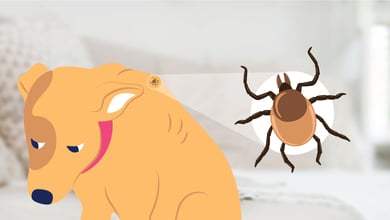Tapeworms in Dogs: Symptoms, Causes & Treatment

Table of Contents
Tapeworms in dogs are a common concern for dog owners, as these parasites can affect the health and well-being of our beloved furry companions. Understanding tapeworms, their causes, symptoms, and treatment options is essential for responsible pet ownership.
By gaining knowledge about tapeworms, you can protect your dog and ensure their continued happiness and vitality.
Key Takeaways:
- Tapeworms are parasites that live in the intestine of dogs and can also infect cats, humans, and other animals.
- Dogs can get tapeworms by ingesting intermediate hosts such as fleas or consuming infected rodents or animals.
- Regular veterinary check-ups and adherence to preventive measures like flea control can help ensure the well-being of dogs and minimize the risk of tapeworm infestation.
What Are Tapeworms in Dogs?
Tapeworms are flat, segmented parasites that reside in a dog's intestine. Scientifically known as Dipylidium caninum, they are the most common type of tapeworm found in dogs. While dogs are a primary host, tapeworms can also infect cats, humans, and various other animals.
These parasites attach to the dog's intestines using their mouth parts. As they mature, they release segments known as proglottids. These segments contain eggs, which are eventually passed out with the dog's feces.
It's not uncommon to spot these segments in a dog's stool, appearing as small, white, rice-like grains. If you notice such white bits in your dog's feces, it's essential to collect a sample and visit your veterinarian for a proper diagnosis.
Hassle-free In-Home Pet Sick Visits
When your pet isn't feeling well, the last thing you want is a stressful trip to the vet. Our in-home sick pet visits offer a calm, stress-free alternative.
What Causes Tapeworms in Dogs
Dogs can get tapeworms by ingesting intermediate hosts that carry tapeworm larvae. The most common source of tapeworm infection in dogs is fleas. When dogs ingest fleas during grooming or biting, they can become infected with tapeworms. Additionally, consuming small rodents or other animals infected with tapeworm larvae can also lead to infection.
A study by the American Veterinary Medical Association, which analyzed fecal samples from 3,000 dogs in 288 U.S. dog parks, revealed that about 21% of these dogs had parasites, including tapeworms.
Given the prevalence of such parasites in dog parks, it's crucial to emphasize the importance of regular veterinary check-ups and preventive measures for our dogs.
Signs and Symptoms of Tapeworms in Dogs
Some dogs with tapeworms may not show any symptoms. However, some dogs may experience the following symptoms:
- Weight loss
- Diarrhea
- Vomiting
- Lethargy
- Itching around the anus, which may result in scooting
- Tapeworm segments in feces
Tapeworm infections can be particularly severe in young puppies, leading to anemia, poor growth, and intestinal blockages.
Should My Pet Be Seen by a Veterinarian?
1. Have you noticed changes in your pet’s appetite?
2. Does your pet have diarrhea or loose stools?
3. Have you noticed changes in your pet’s thirst/water consumption?
4. Is your pet having accidents in the house?
5. Is your pet pacing and unable to settle?
6. Is your pet panting more than usual?
7. Is your pet whining or vocalizing more than usual?
8. Is your pet shaking more than usual?
9. Is your pet hiding or avoiding physical contact more than usual?
10. Is your pet more lethargic and sleeping more than usual?
11. Are you concerned about changes in your pet’s behavior?
12. Is your pet scratching their ears?
13. Is your pet licking their paws more than usual?
14. Does your pet have a rash?
15. Is your pet moving more slowly than usual or having a harder time getting up or down?
View Results
Should My Pet Be Seen by a Veterinarian?
1. Have you noticed changes in your pet’s appetite?
2. Does your pet have diarrhea or loose stools?
3. Have you noticed changes in your pet’s thirst/water consumption?
4. Is your pet having accidents in the house?
5. Is your pet pacing and unable to settle?
6. Is your pet panting more than usual?
7. Is your pet whining or vocalizing more than usual?
8. Is your pet shaking more than usual?
9. Is your pet hiding or avoiding physical contact more than usual?
10. Is your pet more lethargic and sleeping more than usual?
11. Are you concerned about changes in your pet’s behavior?
12. Is your pet scratching their ears?
13. Is your pet licking their paws more than usual?
14. Does your pet have a rash?
15. Is your pet moving more slowly than usual or having a harder time getting up or down?
Share Quiz
Tapeworm Treatment for Dogs
If you suspect your dog has a tapeworm infection, it's crucial to get a diagnosis. This can be done either by spotting segments of the tapeworm in your dog's poop or through fecal testing by a veterinarian.
The primary medication recommended for treating tapeworms in dogs is praziquantel, a common deworming medication. This medication works by paralyzing the tapeworms, effectively killing them. While tablets are the most common form of praziquantel administration, it's also available as injections, topical solutions, and liquid suspensions
When using praziquantel or any other medication, always consult your veterinarian for guidance. It's also worth noting that not every fecal test will detect tapeworms since their segments aren't consistently present in all samples.
Tapeworm Prevention for Dogs
To effectively address this issue, it's crucial to implement proactive measures. Here are some recommendations:
- Keep your dog's yard free of fleas and ticks.
- Prevent rodent exposure.
- Give your dog a monthly flea and tick preventative medication.
- Maintain cleanliness and hygiene.
By adhering to these guidelines, you can greatly reduce the risk of tapeworm infections in your dog.
Conclusion
Tapeworm infections can risk your dog's health. However, by recognizing the symptoms, understanding the causes, and implementing preventive measures like flea and tick control, rodent prevention, and maintaining regular hygiene, you can significantly reduce the risk of infestation.
If you suspect your dog might have a tapeworm infection or if you're looking to ensure they remain tapeworm-free, don't wait. Schedule a visit with your veterinarian. They can offer expert guidance, accurate diagnosis, and recommend the best treatment options.
Frequently Asked Questions
Are tapeworms contagious in dogs?
No, tapeworms are not directly contagious between dogs. Dogs acquire tapeworms through ingestion of intermediate hosts, such as fleas or rodents, that carry tapeworm larvae. However, if an infected dog sheds tapeworm eggs in its feces, other dogs can become infected if they ingest the eggs or come into contact with contaminated environments.
Can humans get tapeworms from dogs?
Yes, humans can get tapeworms from dogs, but the risk is generally very low. The CDC states that tapeworm infections in humans usually occur by accidentally ingesting tapeworm eggs found in contaminated soil or feces.
Can tapeworms kill a dog?
Tapeworms rarely pose a significant threat to a dog's life, but severe infestations can lead to complications if untreated. In rare cases, excessive tapeworms can cause intestinal blockages or malnutrition, particularly in young or small dogs.
Can I use home remedies for dogs with tapeworms?
Some suggest pumpkin seeds, garlic, or apple cider vinegar. However, their effectiveness isn't scientifically proven. Always consult your veterinarian before trying any remedies.






